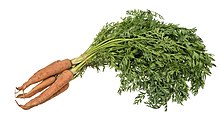**Etymology and Taxonomy**:
– The word ‘carrot’ originates from the Late Latin ‘carōta’ via the Middle French ‘carotte.’
– In Old English, carrots and parsnips were collectively known as ‘moru’ or ‘more.’
– The term ‘carrot’ is linked to the ancient Greek word ‘karōtón,’ derived from the Proto-Indo-European root *ker- (horn).
– Various languages use the same word for ‘carrot’ and ‘root,’ such as the Dutch ‘wortel.’
– The first recorded use of the word ‘carrot’ in English dates back to around 1530.
– Domestic carrot has a single origin in Central Asia.
– Wild ancestors originated in Persia (now Iran and Afghanistan).
– Wild carrot subspecies bred selectively over centuries.
– Wild carrot center of diversity remains in Persia.
– Garden vegetable produced from wild carrot subspecies.
**Description and Botany**:
– Daucus carota is a biennial plant that stores sugars in its taproot during the first year.
– Carrot seedlings have a distinct separation between taproot and stem shortly after germination.
– The taproot of carrots consists of an outer cortex and inner core, with high-quality carrots having a larger cortex.
– Carrot flowers develop in compound umbels, with each umbel containing several smaller umbellets.
– Carrot flowers change sex during development, with the oldest flowers near the edge of the umbel.
– Carrot and stick– Metaphor for the use of punishment and reward.
– Carrot fly– Species of fly.
– Carrot harvester– Harvesting machine.
– Daucus carota subsp. sativus (Hoffm.) Arcang.
– Folio 312, Juliana Anicia Codex Carrot.
**Chemistry and Nutrition**:
– Carrots are rich in beta-carotene, lycopene, anthocyanins, and lutein.
– Black carrots are particularly high in anthocyanins, providing strong antioxidant properties.
– Carrots are a good source of vitamin A, vitamin K, and vitamin B6.
– Carrots are 88% water, 9% carbohydrates, and a good source of dietary fiber.
– Carrot seeds contain oil ducts and canals, with varying sizes ranging from less than 500 to over 1000 seeds per gram.
– Carrot seed oil– Essential oil extract of carrot seed.
**Cultivation and Production**:
– The United Nations FAO reported a global production of 41 million tonnes of carrots and turnips in 2020.
– China accounted for over 44% of the world’s carrot production in 2020.
– Carrots come in different colors, including orange, purple, black, red, white, and yellow.
– Carrots are commonly consumed raw or cooked in various cuisines worldwide.
– Carrots grown initially for leaves and seeds.
– Carrot seeds found in Switzerland and Southern Germany dating back to 2000–3000 BC.
**Storage, Uses, and Culinary**:
– Carrots can be stored for several months in the refrigerator or in a cool, humid place.
– Carrots are versatile and can be consumed raw, boiled, fried, or cooked in various dishes.
– Baby carrots are a popular snack food and can be dehydrated for chips or flakes.
– Carrot juice is marketed as a health drink and can be blended with other fruit juices.
– Carrots contain essential minerals such as calcium, iron, and potassium.
– Carrots can be cooked in various ways like boiling, frying, or steaming.
The carrot (Daucus carota subsp. sativus) is a root vegetable, typically orange in color, though heirloom variants including purple, black, red, white, and yellow cultivars exist, all of which are domesticated forms of the wild carrot, Daucus carota, native to Europe and Southwestern Asia. The plant probably originated in Persia and was originally cultivated for its leaves and seeds. The most commonly eaten part of the plant is the taproot, although the stems and leaves are also eaten. The domestic carrot has been selectively bred for its enlarged, more palatable, less woody-textured taproot.
| Carrot | |
|---|---|

| |
| Scientific classification | |
| Kingdom: | Plantae |
| Clade: | Tracheophytes |
| Clade: | Angiosperms |
| Clade: | Eudicots |
| Clade: | Asterids |
| Order: | Apiales |
| Family: | Apiaceae |
| Genus: | Daucus |
| Species: | |
| Subspecies: | D. c. sativus
|
| Trinomial name | |
| Daucus carota sativus | |
| Synonyms | |
| |
The carrot is a biennial plant in the umbellifer family, Apiaceae. Young plants have a rosette of leaves while building up the enlarged taproot. Fast-growing cultivars mature within about three months (90 days) of sowing the seed, while slower-maturing cultivars need a month longer (120 days). The roots contain high quantities of alpha- and beta-carotene, lycopene, anthocyanins, lutein, and are a good source of vitamin A, vitamin K, and vitamin B6. Black carrots are one of the richest sources of anthocyanins (250–300 mg/100 g fresh root weight), and hence possesses high antioxidant ability i.e. almost 20–35 times higher than red/orange carrots and five times higher than beetroot.
The United Nations Food and Agriculture Organization (FAO) reports that world production of carrots and turnips (these plants are combined by the FAO) for 2020 was 41 million tonnes, with over 44% of the world total grown in China. Carrots are commonly consumed raw or cooked in various cuisines.
